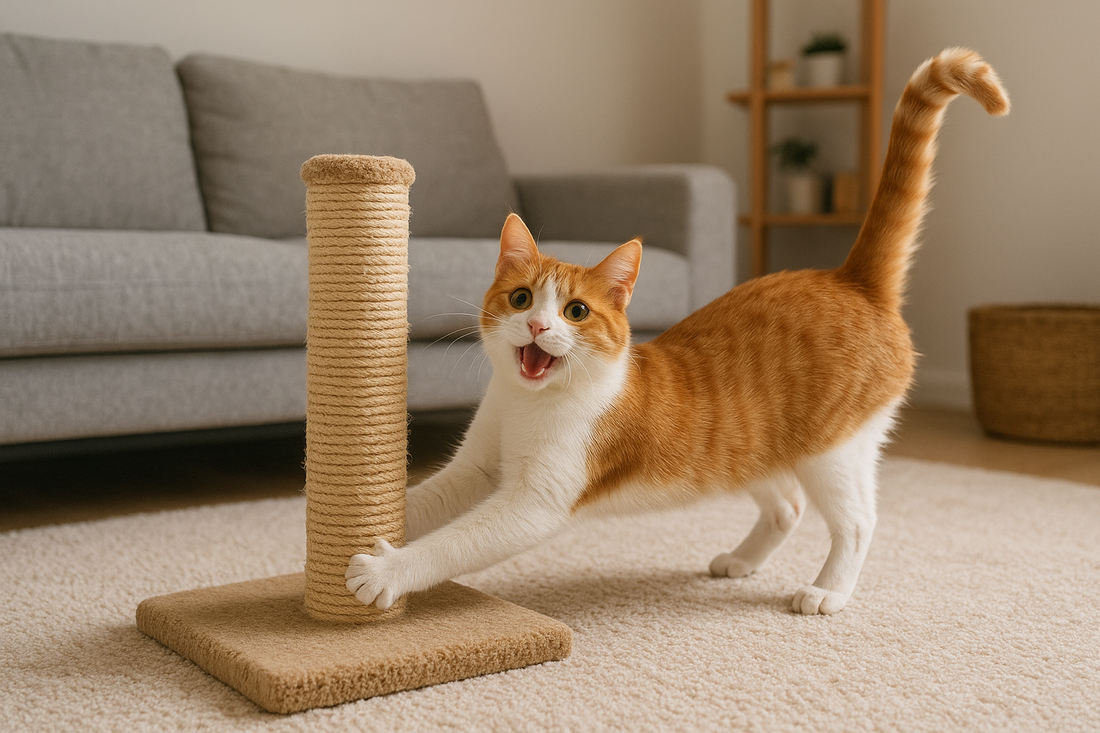
How to Stop Your Cat from Scratching Furniture?
Why Cats Scratch - And Why It’s Actually a Good Thing
Scratching is one of the most natural — and essential — feline behaviors. It’s not just about sharpening claws or acting out; it’s deeply instinctive and tied to both their physical and emotional well-being. Unfortunately, our furniture sometimes becomes the unintended victim of these perfectly normal urges.
Before you get frustrated, it’s important to understand why your cat scratches in the first place. Once you know the logic behind it, redirecting that behavior becomes much easier and less stressful for both of you.
 1. Claw Maintenance
1. Claw Maintenance
When cats scratch, they shed the outer sheath of their claws. This process keeps their nails sharp, healthy, and functional. Without proper outlets, nails can become overgrown or split, leading to discomfort or health issues.
2. Territory Marking
Cats communicate through scent as much as sound. Their paws contain scent glands that release pheromones when they scratch. By leaving both visible and scent marks, cats claim ownership of their space. To your cat, that corner of the couch isn’t just fabric — it’s part of their personal domain.
3. Exercise & Stretching
A good scratching session gives your cat a full-body stretch. It engages their shoulders, back, and legs, promoting flexibility and muscle tone. Think of it as feline yoga — essential for comfort and health.
4. Stress Relief
Scratching can also serve as an emotional outlet. Cats often scratch more when anxious, bored, or overstimulated. It’s their way of releasing tension, much like humans might fidget or tap their fingers.
👉 Bottom line: Scratching isn’t “bad behavior.” It’s communication, exercise, and self-care rolled into one. The key is guiding it to the right places.
✅Proven Ways to Stop Your Cat from Scratching Furniture
Cats don’t scratch to annoy you — they scratch because they need to. Your goal isn’t to stop the behavior, but to redirect it. Here’s how to do it effectively and humanely.
1. Provide the Right Scratching Alternatives
 🪵 Scratching Posts
🪵 Scratching Posts
Start by placing sturdy vertical scratching posts near the furniture they already target. Cats often return to the same spots out of habit, so position new posts nearby. The post should be tall enough for a full-body stretch — at least 30 inches for most adult cats.
📦 Scratching Pads & Boards
Some cats prefer horizontal surfaces. Flat cardboard scratchers or inclined boards can be irresistible for cats that love to dig down rather than stretch up.
🌳 Cat Trees & Towers
Multi-level cat trees serve triple duty: climbing, perching, and scratching. They provide both exercise and territory, satisfying your cat’s need for vertical space and mental enrichment.
💡Pro Tip: Experiment with different materials - sisal rope, carpet, corrugated cardboard to discover your cat’s favorite texture. Every cat is unique!
2. Use Cat-Friendly Deterrents
 Sometimes, you need to make certain furniture less appealing while encouraging better scratching spots.
Sometimes, you need to make certain furniture less appealing while encouraging better scratching spots.
🛡️ Furniture Protectors
Clear vinyl guards or sticky tape panels can stop scratching instantly. Cats dislike sticky or slick textures under their paws, so these tools gently discourage unwanted scratching without harm.
💧 Deterrent Sprays
Pet-safe sprays with natural ingredients can repel cats from particular surfaces. Look for non-toxic options — never use essential oils directly on furniture, as some can be harmful to cats.
🍋 Scent Deterrents
Cats tend to avoid citrus or lavender scents. Lightly misting diluted sprays in high-risk zones (never on your cat!) can help prevent scratching.
💡 Tip: Always test deterrents on a small, hidden area first to ensure they won’t damage fabrics.
3. Make Furniture Less Tempting
 You can protect your sofa and help your cat form new habits by modifying the environment slightly.
You can protect your sofa and help your cat form new habits by modifying the environment slightly.
🛋️ Cover Favorite Zones
If there’s a go-to corner your cat attacks, temporarily cover it with a throw blanket or slipcover. The change in texture will often break the habit.
🔄 Rearrange Furniture
Cats are creatures of routine. Shifting the layout or moving the furniture a few inches can make old targets less familiar — and less attractive.
✂️ Trim Nails Regularly
Keeping your cat’s nails trimmed reduces damage if scratching happens. Use feline nail clippers and reward them afterward to create positive associations.
4. Encourage Positive Reinforcement
 The fastest way to change your cat’s behavior? Reward what you do want to see.
The fastest way to change your cat’s behavior? Reward what you do want to see.
🍖 Reward the Right Behavior
When your cat uses their scratching post, immediately praise them or offer a small treat. Consistent, timely rewards reinforce the desired behavior far better than punishment ever could.
🌿 Use Catnip or Silvervine
Rubbing catnip or silvervine powder on scratching posts can draw cats in like a magnet. These natural stimulants make posts more exciting than your furniture.
🚫 Avoid Punishment
Never yell, spray water, or physically punish your cat for scratching. These reactions only increase stress and can damage trust. Instead, redirect gently by guiding them to the proper scratching surface.
💡Pro Tip: Incorporate scratching into playtime! Dangling a feather toy near a post can encourage your cat to grab and scratch naturally.
5. Maintain Your Cat’s Nails
 Healthy claws mean less damage — even when scratching happens.
Healthy claws mean less damage — even when scratching happens.
✂️ Regular Trimming
Most cats benefit from nail trims every 2–4 weeks. If your cat resists, start slowly: trim one or two nails per session and reward them generously.
🧤 Soft Nail Caps (Like Soft Paws)
These small silicone caps fit over your cat’s claws, preventing scratches without affecting their ability to walk, climb, or retract claws. They typically last 4–6 weeks and can be a great temporary fix while training your cat to use scratching posts.
🧸 Keep Calm and Patient
If nail care stresses your cat, ask your vet or groomer for a demonstration. Proper handling can make all the difference.
⚠️ Common Mistakes Cat Owners Make
Even with the best intentions, some common missteps can slow progress or worsen scratching issues. Here’s what not to do:
❌ Declawing Your Cat
Declawing is not a simple nail trim — it’s a painful surgical procedure that removes part of each toe bone. It often leads to chronic pain, arthritis, and behavioral issues. Humane alternatives like nail caps or regular trims work far better.
❌ Punishing or Scaring Your Cat
Yelling, spraying water, or using loud noises can create fear without solving the root problem. Fear-based responses can even make cats scratch more out of stress.
❌ Choosing the Wrong Scratching Surface
Each cat has unique preferences. A horizontal scratcher won’t satisfy a vertical scratcher and vice versa. Offer variety until you find what works.
❌ Hiding the Scratching Post
If the post is tucked away in a dark corner, your cat may never use it. Instead, place it in visible, high-traffic areas — especially near furniture they’ve targeted.
❌ Being Inconsistent
Mixed signals confuse cats. If you allow scratching “sometimes,” they’ll struggle to understand the rules. Stay consistent: every time they scratch inappropriately, redirect calmly.
👉 Consistency + patience = success. Cats learn through repetition, not punishment.
🩺 When to Seek Extra Help
 If your cat’s scratching feels excessive, destructive, or stress-related, it might be time to consult your vet or a certified feline behaviorist.
If your cat’s scratching feels excessive, destructive, or stress-related, it might be time to consult your vet or a certified feline behaviorist.
Some possible underlying causes include:
- Anxiety or boredom (especially in indoor-only cats)
- Lack of enrichment or play opportunities
- Health issues affecting claws or joints
- New pets or changes in the home environment
A professional can help identify triggers and tailor solutions to your cat’s unique personality and needs.
💡 Tip: Enriching your cat’s daily routine - through play, climbing spaces, and mental stimulation - often reduces stress-related scratching.
Bonus Tips for a Scratch-Free Home
✔️ Rotate scratching toys regularly to keep them exciting.
✔️ Add vertical spaces like wall shelves or cat trees to expand your cat’s territory.
✔️ Create daily play sessions using wand toys or chase games to burn off energy.
✔️ Sprinkle catnip weekly on scratching posts to maintain interest.
✔️ Place posts near sleeping spots - cats often scratch right after waking up.
These small adjustments make a big difference in long-term behavior.
💡 Final Thoughts
Stopping your cat from scratching furniture isn’t about punishment - it’s about partnership. Cats scratch to stay healthy, stretch their muscles, and mark their space. When you understand and respect this instinct, it becomes easy to guide it in a positive direction.
By offering enticing alternatives, using gentle deterrents, and reinforcing good habits, you can protect your furniture and strengthen your bond with your feline friend.
So don’t fight their nature - work with it.
Your sofa (and your cat’s claws) will thank you. 🛋️🐱
Tags: Cat scratching solutions, Stop cat scratching furniture, Cat behavior tips, Scratching posts and alternatives, Cat training made easy, Cat care and wellness, Cat owner tips, Protect furniture from cats
